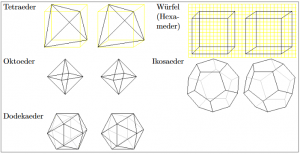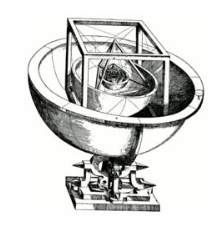Platonic bodies
Platonic solids (or: ideal solids, regular polyhedra — “polyhedra“) are convex solids with the greatest possible regularity, named after the Greek philosopher Plato (427–347 BC). (Here a body is called convex if with two each of its points ![]() and
and ![]() also all points on the connecting line
also all points on the connecting line ![]() belong to it).
belong to it).
This (“greatest possible“) regularity consists in the fact that for each of these solids all side faces are congruent (“congruent”) to each other and that they meet in the same way in each corner.
There are exactly five Platonic bodies:



